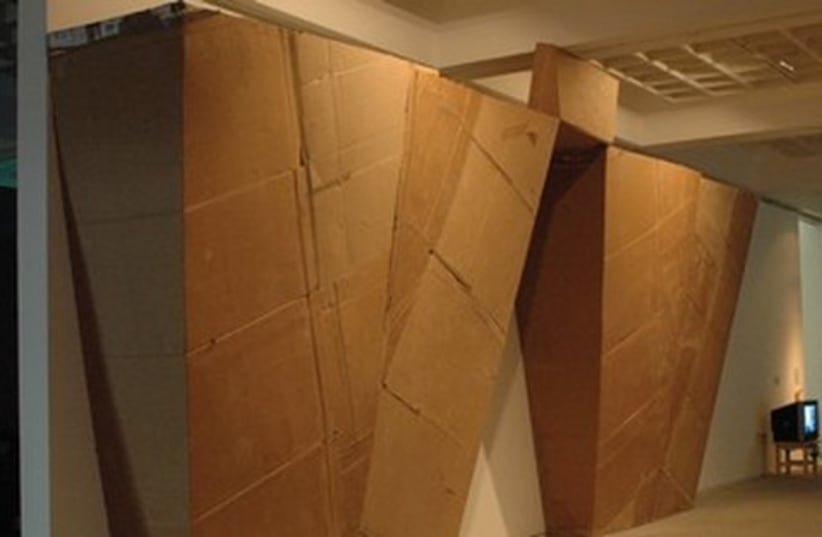There is something almost animated about your sculptures...
I’m not sure why. It may be because they’re improvisational in style, quality. In the case of this show, I prepared some sketches, thought about it, but mainly I started working. It was like this with the object I made for the Tel Aviv Museum [of Art] – Bridge [2006] – a rather monolithic construction out of wood and cardboard that copied the legs of the Yarkon Bridge. In Herzliya, I was invited by the museum to do something inside an empty hut they had, but instead I put a hole in the roof and built a fake chimney. On top of that, I put a stork in a nest and built a whole façade in the style of a fairy tale. I called it Transitory Residents [2008].The sculpture I do is about space – a collage or composition in three dimensions. It relates to form, to the spectator, to points of view, to the place the object occupies in the space. I also like to use materials that look second- or even third-hand. First and foremost, it’s a question of composition. Then I take it from there.Sometimes it’s a structural element, whereas for this show I chose a peacock, which adds a kind of story.
For me a peacock brings back childhood memories of visiting the Ramat Gan Zoo – throwing me straight back in time.Sure, for me it’s the Petah Tikva Zoo, where I think we even had a pair of white peacocks. When I’m not doing something very communicational – like comics or animation, which follow a tradition in one way or another – but rather things like poems, collages, sculptures, then I often try to bring the experience of time being cut off or disconnected.As a kid I think I could disconnect almost absolutely from the things around me while looking at something – whether it was a line of ants or Ma’ariv art books at my grandma’s. I don’t know whether to call it meditation, but it’s something having to do with deep contemplation. I like works that, by looking at them, you get this feeling.Beyond all the knowledge involved in so-called smarter art – which I don't mean to undervalue – it’s not enough for me. Once my dad said that if you present a riddle, then there should be a solution. But this is not a riddle – there’s no solution. It’s a question of visuals that I hope get stuck in someone’s head the way that visuals get stuck in my head.
There’s also the issue of size – your sculptures tend to be large or else built in such a way that it’s hard to get close and see the details.
When you have to step back to see something big, you lose details, but you see something else that you can’t see in the details. It’s like being a spectator at a soccer game – if you’re not one of the players, you want to get a nice wide view of the whole game. In the end, art is an experience of spectating. You’re not looking at nature. You’re looking at art. The art space is one of exhibition.I don’t think I play with the borders of the field of art. Art can’t be a lot of things other than art – and this is enough. I try to look at art itself from a distance, the way I look at the work itself. It may look primitive or outside, but this is in part because I’m always playing. The experience of coming to a gallery has its rules. Even if you’re annoyed, it’s still within the rules of the game.
This exhibit seems somehow different – perhaps a bit calmer...
I hope so. As a spectator I tend to get bored. I notice repetitions in movies that have similar plots.... So I hope there is some sort of progress in these things. That they change. That it won’t be about doing the same thing again. That it’ll pique some curiosity. The same thing I expect as a spectator.There’s also a conscious attempt to flee from drama. Perhaps from myself. To say, yes, yes, it’s here, take a look, I’ll come by later. The peacock’s tail isn’t spread out – but he’s still a peacock. There’s that childhood memory where you go to the zoo and don’t want to be disappointed by the peacock’s tail not being spread out. But he’s still a peacock even without the dramatic display.■ The exhibit by sculptor, collagist and cartoonist Boaz Kadman was curated by the writer and will be on show until July 6 at Barbur Gallery, 6 Shirizli Street, Nahlaot, Jerusalem.
